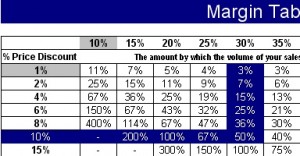Last year I read a book by Oren Harari called Break From The Pack: How To Compete in a Copycat Economy. It is a book worth reading and certainly challenges the idea that the best way to build a great business is to copy what everyone else is doing.
One of the concepts Harari introduced that I particularly liked is what he calls the Madonna Effect. Madonna, he notes, is a phenomenally successful pop star having sold more than 140 million albums over 25 years but in addition to that her concerts are sell-outs, she’s done movies, written books and created videos. Robbie Williams, himself a gigantic star, says “she’s an absolute legend and makes us all look like amateurs.”
Madonna obviously has staying power in a very fickle industry. Harari notes that her success comes from her “extraordinary ability to reinvent herself in anticipation of many fashions.” Every couple of years she comes up with a new way of presenting herself and her work. She takes note of what other groups are experimenting with, then in her own creative way she gets in front of the pack and leads her audience there—far enough away from conventional wisdom to be considered somewhat of an edgy rebel but not so far to be labeled bizarre. This is not unlike the famous statement made by Wayne Gretzky when asked why he scored so many goals in his career he said, “I skate to where the puck is going to be, not where it has been.”
The ability to re-invent yourself is a characteristic of great business leadership. Our environment is in a continuous state of change and in such circumstances businesses need to cintinuously re-think their business model. You need only look at IBM under both Lou Gerstner and then Sam Palminsano and to all of the “Good to Great” companies documented by Jim Collins to realize that the difference between ordinary and great is a willingness to apply the Madonna Effect. The leaders of all of these companies took a critical look at where they were and made a conscious decision to go to a better place.
If you accept the proposition that winners stay ahead of the pack you should be behaving as a Madonna. Here’s a self test that I have put together based on Harari’s thoughts that you might like to use to determine how well you are doing at it. On a scale of 1 to 5 where 1 is a resounding NO and 5 is a resounding YES how does your firm stack up?
No matter how good you are now you know in your heart that change is inevitable and that good today does not mean good forever. You’re therefore constantly looking for better ways of doing things and for different market opportunities.
You closely monitor trends in your environment and visualize how your firm will be taking advantage of a different set of circumstances.
You are not afraid to walk away from current products, services or customers or if you believe there is a greater opportunity to deploy your resources for greater long term returns elsewhere.
You constantly experiment with new ideas and you invite your customers to experiment with you and help you find better ways to create value for them.
You are deliberately provocative. Your ideas may range from the sublime to the ridiculous but you could never be accused of being indifferent.
You passionately believe in a different future for your business and your ability to prevail but you are still firmly connected to reality. Jim Collins refers to this as the Stockdale Paradox and notes that it is a fundamental characteristic of all the great companies he studied.
You are always upbeat, optimistic and excited about the future and what opportunities it offers your firm to break from the pack.
How did you score yourself?

